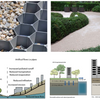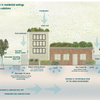What to do in your wicking bed this month - June 21

Wicking bed gardening in June
Feeding yourself from balcony planters
This month, I thought I would continue on the small planter theme, but back in relation to growing edible plants. Six weeks ago I started a vegetable garden in nine (9) WaterUps Square Planters that would fill a normal sized sunny balcony. The WaterUps Square Planters hold 50L of soil and a huge 19L of water in the reservoir.
Planting
From the moment I got my hands on the planter, I knew that it would be a great size for vegetables. However, I also knew that I needed a bit of restraint, to not get too greedy and try to squeeze too much in. With this in mind, I set out to plant as much as I could in each pot. For the larger vegetables, like cauliflower and cabbage, I planted one in each corner, four in total and for the vegetables that need a little less space, such as silverbeet, Chinese cabbage and garlic, I put nine plants in each planter.
Soil preparation
Preparation of the soil was the same as with the Oasis beds. After you have added 2 x 25L bags of high quality organic vegetable potting mix to the planter, you should also add one handful of organic fertiliser pellets and mix through. The reason for not simply spreading the pelletised fertiliser on the surface of the soil, is that this technique is only effective if water is consistently applied from the top to slowly dissolve the pellets, washing them down to the root zone. As we will not be watering from the top except when the seedlings are first planted and when adding a solution of liquid fertiliser, it is important to mix the pellets through the soil to ensure contact with the soil microbes. The microbes will feed on the fertiliser and in turn feed the plants.
Positioning of planters
Once the soil is installed and prepared with fertiliser, plant out your seedlings. The advantage of using the small planter is that you can place it in an area that gets the most sun. This is especially important in Winter when sunlight is at a premium.
Planting
When planting out your seedlings, don’t get greedy and try to stuff more than the planter can handle. As I mentioned earlier, in most cases 4 plants per planter will ensure that each plant gets enough space, nutrients and light. Read the seed or seedling label to get the right distances. You can plant the seedling right up close to the edge of the planter. This means that any vegetable that needs to be planted 50cm apart can be positioned in the corners allowing you to fit four into the planter. After the seedlings have been planted at the correct spacings, water in with a full 9L watering can containing a half strength liquid fertiliser or seaweed extract. A second watering can of straight water can be added directly to the inlet pipe to finish filling the reservoir. Mulch the soil in your planter to a depth of just a few centimetres and sit back.
Fertilising
Just because you add water to the inlet pipe does not mean that you cannot liquid fertilise from a watering can just like any other garden or planter. I have been fertilising my vegetables every two weeks with an organic liquid feed to supplement the pellets and support the organic matter in my soil.
Watering
Once I have applied the liquid fertiliser, I wait for about 10 minutes for most of the liquid to make its way through the soil and any excess to have drained into the reservoir. I then check the level in the reservoir. If at this point the water level is right at the bottom, I will refill.
Pest control
My plants have grown quickly and with a consistent water supply and enough nutrients, I have not experienced any pest attack. One of the reasons for this is that surface watering can lead to excess soil surface moisture, which is a major cause of fungal outbreaks. In most but not all cases, however, a well-feed and sub-irrigated or bottom-watered plant will fight off unwanted bugs.
Vegetables growing in WaterUps products do require a lot less attention, but don’t think that they can do it alone. Even though you may not need to water your vegetables each day, you must check them for any signs of pest attack. Treat any unwanted bugs immediately to ensure great produce.
To buy one of our Square Planters click here
Eric studied horticulture at the University of Western Sydney at the Hawkesbury Agricultural Campus, North Richmond. Over the next few years, he worked in large show gardens and high end nurseries before starting his own landscape and maintenance business.
In 2016 the opportunity arose for Eric to work for North Sydney Council as the coordinator for their volunteer gardening program, Streets Alive. After running a six week side by side trail with the WaterUps system versus his 25 years of horticultural knowledge and experience, he realised what a fantastic and revolutionary system this was. He soon after joined WaterUps.








